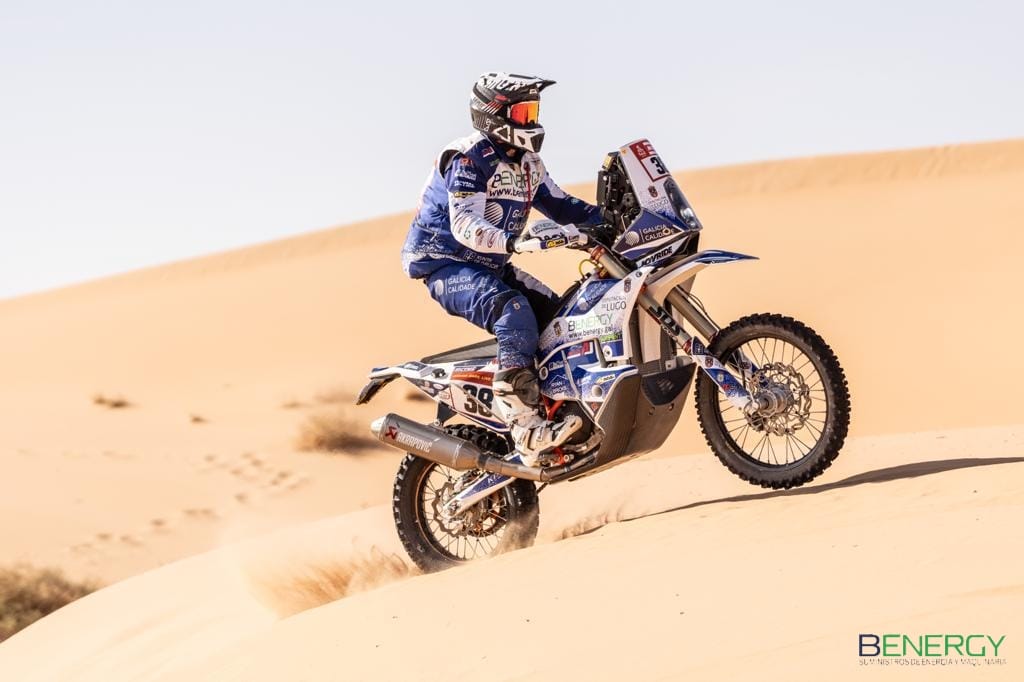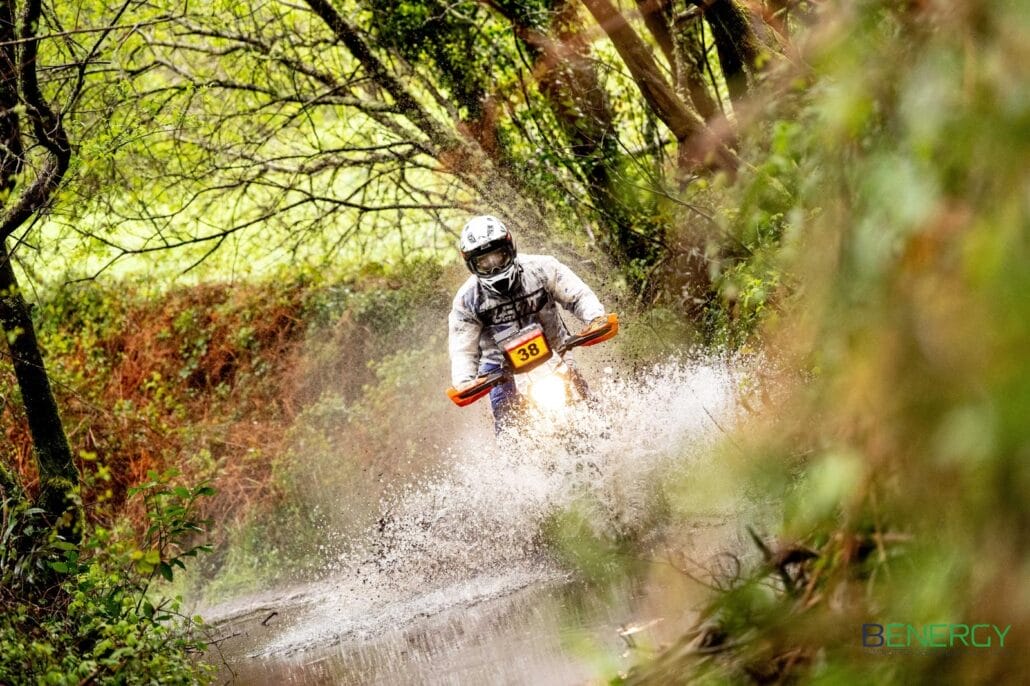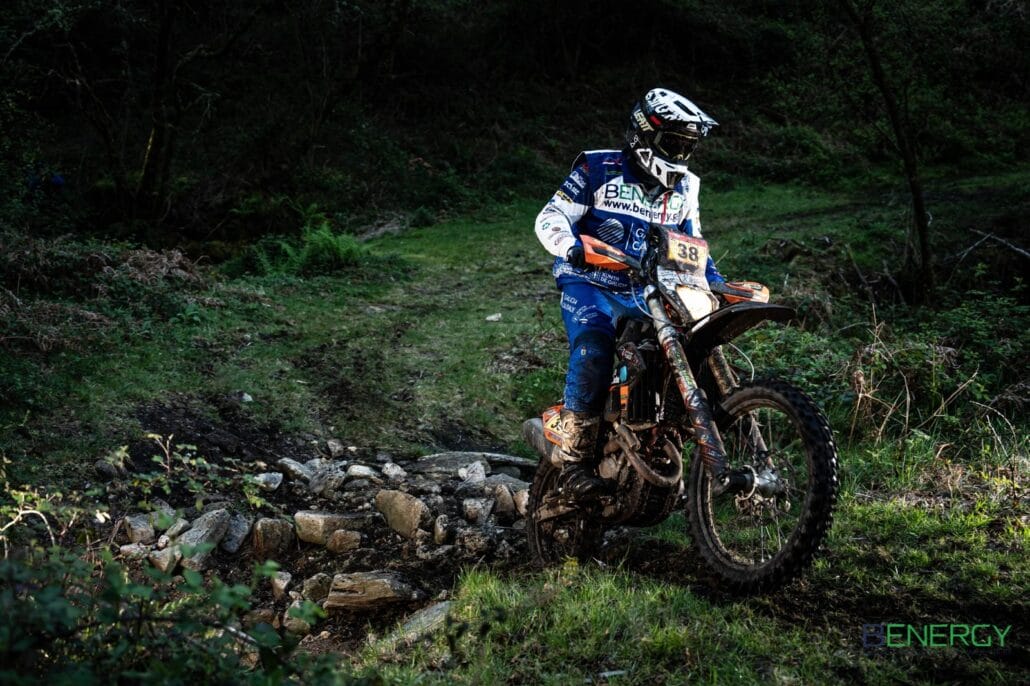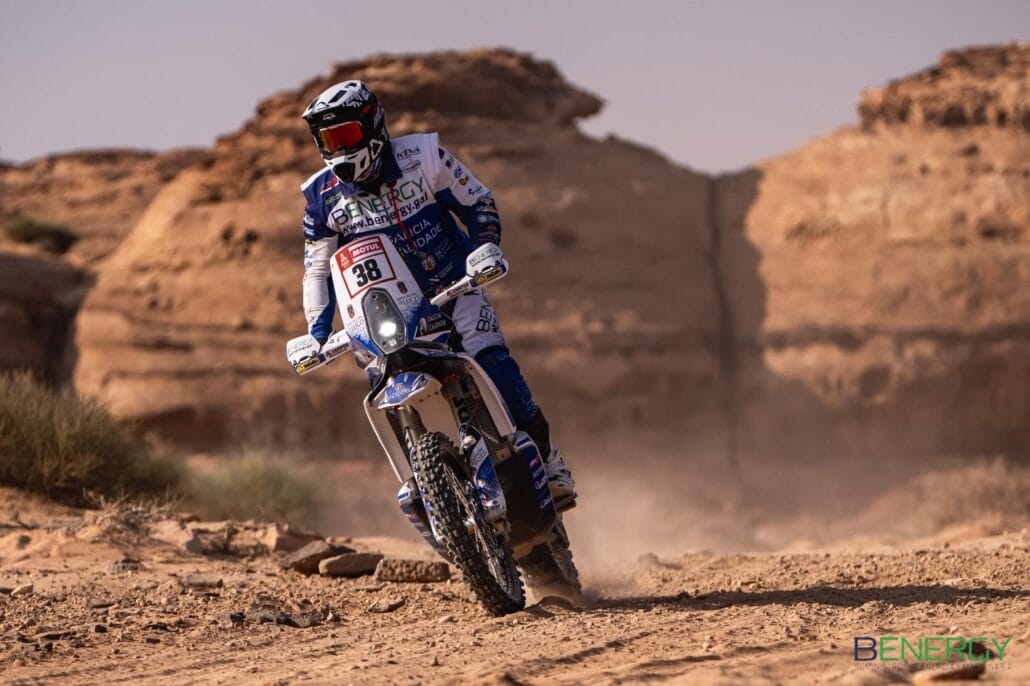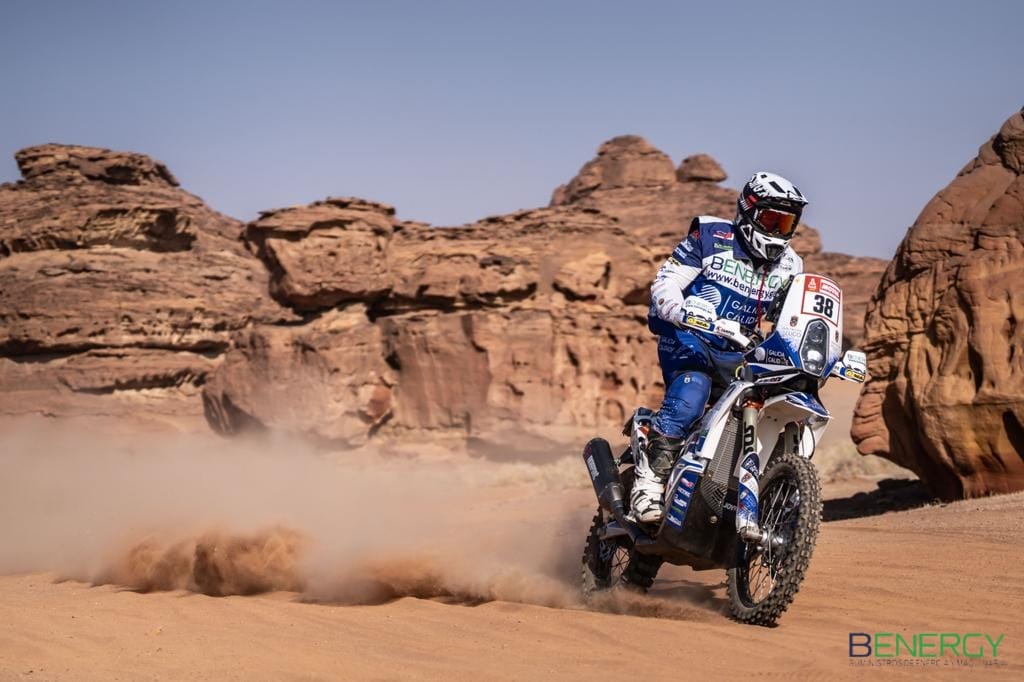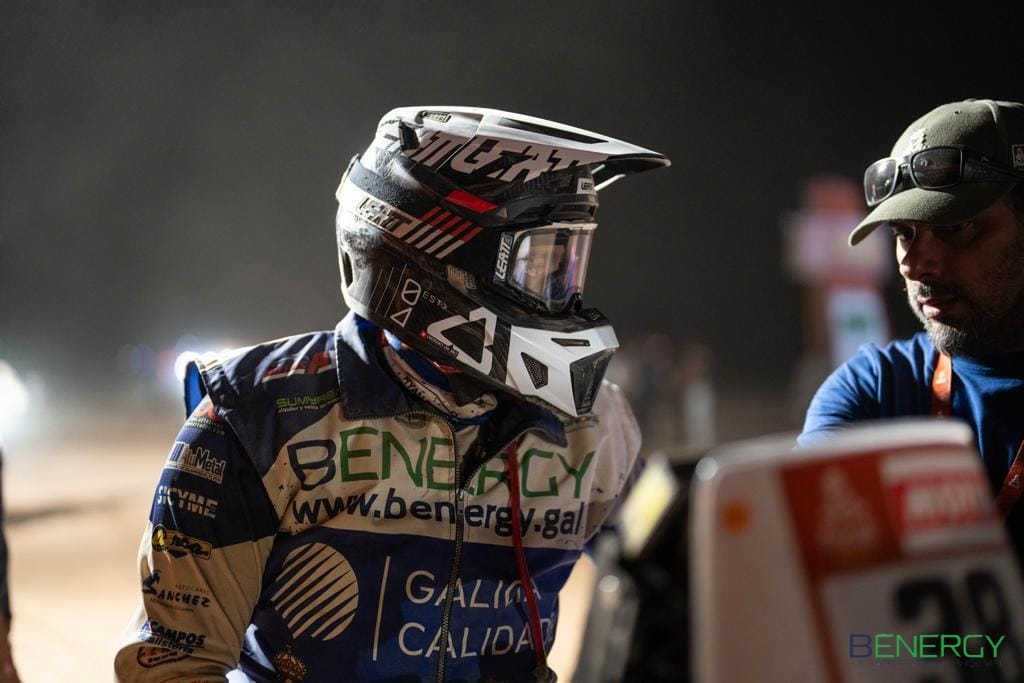We navigated with the Galician rider from that fateful moment, through his battle against his own fears, to his most immediate goals.
Eduardo arrived more prepared than ever for Dakar 2023: “I qualified very well in both the Hellas Rally in Greece and the Dinaric Rally in Croatia; and the 1000 Dunas had been great training.” But in the early stages of the prologue, Edu was forced to abandon the Dakar. A disastrous fall broke both his clavicles. Despite the moral blow and the physical pain being so present, Edu was clear about one thing. “When I was on the plane after breaking my clavicles, I already knew I had to return to the Dakar. I told my mother right after the operation, and she couldn’t believe it. I knew this couldn’t end like this. After finishing three editions, I didn’t want this to be my story in the Dakar. It couldn’t be. I had to fight to be at the start again.” He recalled with calmness: “The accident was a very hard moral blow, but I wanted to get back on the bike as soon as possible to recover from the psychological damage. After ten days, I was already going to the gym and shortly after, I was back on the bike.” But once again, reality hit hard. “In April, I went to train in Morocco with the idea of running the Sonora Rally, but even though my clavicles were healed, the psychological part was still missing. I wasn’t ready, and it took me a lot to feel comfortable on the bike again.”
Returning to competition, he discovered that he still had a long way to go in his recovery: “I arrived at the Hellas in May 2023 and realized it. I had tremendous stage fright. It was a very rainy rally, so I was afraid of getting hurt in every stage, and even though I finished 1st in M2, I placed in the twenties overall. In September 2023, we did the Rally Adventure Galicia. I felt better, but on the first day, I had a very hard crash and thought I had broken my clavicles again.” Concluding, he said: “I spent the whole year fighting against my mind, and even feeling good, I was cutting the throttle.”
In January 2024, the moment of the ultimate test arrived. After a year of searching for good sensations, it was time for Eduardo Iglesias to face his ghosts, and with clear ideas, everything seemed to fall into place. “To go to the Dakar, you have to find a goal. After finishing it, you need to motivate yourself to train and be at the start again. If my goal for other editions had been to improve my position, for this 2024 edition, it was to remove the thorn and prove to myself that after a traumatic injury, because of how it happened, the Dakar couldn’t finish me.” But the uncertainty was total: “I was in good physical shape, but I didn’t know how I would respond psychologically in a race as tough as the Dakar and with last year’s tragedy in my mind, you can imagine.” Even though he was making progress in the right direction, the harshness of this race imposed itself once again in the worst possible way. “The prologue was very tense… but once it was over, in the early stages, as complicated as they were, I started to feel good… until Carles’ accident. It was another very hard psychological blow that hit us closely. Very difficult to take.” -Spanish rider Carles Falcón passed away days later as a result of the accident-.
Edu was determined to finish the Dakar but was still unaware of the harshness that was yet to come. “I encountered the toughest Dakar in recent years.” The 48-hour stage seemed to have left a mark on his memories that he hurried to recount: “At km 2, I was already stuck in soft sand; at km 3, on a huge dune with a terrifying descent, I overdid it with the throttle at the top, and the bike fell. I struggled a lot with the bike and the sand to continue; and at km 9, I found Zacchetti in a hole, and by looking at him, I got stuck too. We helped each other to get out, but all this happened before reaching km 10 of a 600 km stage. Imagine! We spent a good while pushing the bikes. At that moment, I must have been almost the last of the stage, but little by little, I caught up with other riders as I crossed incredible dunes with vertigo-inducing descents.” Aware of the harshness of the stage, Edu decided to recalculate his objectives to reach the bivouac at km 300: “At around three in the afternoon, I refueled, and with the mandatory twenty-minute stop, I left around twenty to four. With 100 km ahead, I thought I wouldn’t make it to the bivouac at km 300, but I had to keep going even if I had to sleep in the dunes. With a good pace at first and suffering a lot, I reached the camp just as night fell.”
The second half of the 48-hour stage was still ahead, and the price for removing that thorn involved a degree of suffering previously unknown to him. “The next day, the first few kilometers were very tough, and around midday, with the sun overhead, the bike fell on me many times. I’ve never had to lift it so many times in my life.” Reaching such a physical extreme that: “I wished the bike would break so I could call the helicopter and go home. I think I never pushed my body to such a limit. I don’t even know how to explain it: You can push yourself to the max on a gym machine, but it’s not the same; it’s a limit you can’t control. It’s a limit I had never experienced in any other Dakar. I had cried on other occasions, I had suffered a lot, but I didn’t know that physical limit.” he affirmed with conviction.
Having finished Dakar 2024 and overcoming the trauma, Edu is now facing two races in the European championship. One in Galicia and another in Greece, with their ups and downs. “The Rally Adventure Galicia benefited me a lot. Without navigation errors or falls, I finished 1st in M2 with the 350cc, which was a great option for this rally; 5th in the national classification and 2nd in the European one, so I ended up very motivated for the Hellas Rally,” where he didn’t feel as comfortable. “The type of tracks and trails in the Hellas were more suited for the 450cc than for my 350cc, with which I suffered more than usual. Besides, the level increased dramatically with many top Dakar riders, and even finishing 2nd in my category, I placed 22nd overall.” Edu lamented, concluding with a positive reflection on his performance in the European circuit: “But I’m happy. I’ve competed in two races in Croatia, three in Greece, two in Galicia… and I’m always at the top. I’m not one of the fastest riders, but I always manage to maintain a consistent average with few navigation errors, avoiding many troubles, and preserving the mechanics.” fundamental keys to achieving these endurance races.
Edu faces the rest of the year with the uncertainty of someone whose ultimate goal is the Dakar Rally. “I don’t have confirmation for Dakar 2025. No matter how much intention we have, we ultimately depend on sponsors, so in these months, we’ll have to make the final decision.” So his proposals include a continental championship: “I’ll try to finish the European championship in August, in Romania, to fight for the title, which will also be another race towards the Dakar if we finally decide to go.” And another more domestic, albeit international in nature: “I will also run the Six Days in October, here in Galicia.” A race the Galician rider had already competed in 2009 in Portugal and now repeats at home with friends. “It’s the Enduro Olympics. It’s a race with a lot of international atmosphere, and being here, I had to be there. I will participate with Alejandro Vieitez and Giovanni Pérez, classifying for clubs in teams of three riders.” he said with the enthusiasm of someone competing at home.
As a true Dakar participant, Edu does not lose sight of his goal or the necessary tasks to achieve it, assuring that: “If I finally go to the Dakar, I will participate in the Addax Rally in November to be as well-prepared as possible.”
Source and photos: Pablo Pillado/Eduardo Iglesias
- PROFESSIONELLE REITSCHUTZWESTE: Diese Motorrad-Airbag-Weste verfügt über eine hochwertige Konstruktion mit CE-zertifiziertem PE-Rückenprotektor, um empfindliche Körperteile bei Stürzen zu...
- LEICHTE WESTE: Die Moto Airbag Weste ist auch superleicht, so dass sie bequem über Ihrer Lieblingsjacke oder Ihrem Lieblingsmantel getragen werden kann! Er ist so leicht, kühl und bequem, dass Sie...
- MATERIAL: Motorrad-Airbag-Weste Hergestellt aus 600D Polyester Oxford und Mesh-Gewebe, mit ausgezeichneter Verschleißfestigkeit und Reißfestigkeit. Langlebig wasserdicht, winddicht und atmungsaktiv.
- WESTE MIT REFLEKTIERENDEM STREIFEN: Mehrere reflektierende Materialien auf der Vorder- und Rückseite, die die Sichtbarkeit bei schlechten Wetterbedingungen verbessern und die Sicherheit des Fahrers...
- MOTORRAD-FAHRAUSRÜSTUNG: Hochwertige Schutzausrüstung ist während der Fahrt unerlässlich. Diese komfortable Motocross Airbag-Weste bietet Ihnen optimale Mobilität und Schutz auf Autobahnen,...
Letzte Aktualisierung am 2025-09-15 / *Affiliate Links / Bilder von der Amazon Product Advertising API
